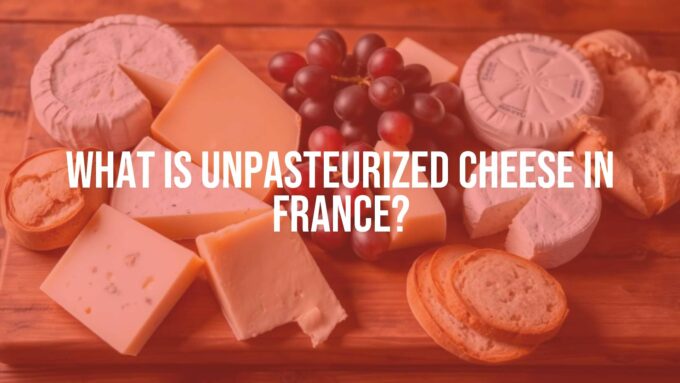French cheese is world-famous, often bringing to mind country farms, green fields, and perhaps a good glass of wine. France is known for creating countless types of cheese. But what makes all these French cheeses different or special? Behind each cheese is a mix of tradition, place, and careful handiwork-so much so that Charles de Gaulle once joked, “How can you govern a country with 365 kinds of cheese?” Depending on who you ask, there are anywhere between 1,000 and 1,600 types when you count all the variations. This guide will help you discover what makes French cheeses unique.
French cheese is all about tradition and a serious love for quality. From the soft and gentle Brie de Meaux to the bold taste of Roquefort, each cheese comes from a particular region and starts with fresh milk. The wide range of flavors and textures mirrors the different landscapes across France, making any selection of French cheese a true taste of the country.

What makes each French cheese type different?
Understanding French cheese isn’t only about knowing their names; it’s also about how they’re made, the local ingredients used, and why their origin is protected by specific rules. All of these factors play a part in giving each cheese its taste, feel, and smell.
How are French cheeses organized?
French cheese isn’t just made randomly. There’s a well-established system that groups cheeses and helps protect their quality and heritage. French cheeses fit into eight main groups, or “familles de fromage.” Cheese production itself is also separated into four categories:
- Fermier: Farmhouse cheese made right on the farm with the farm’s own milk.
- Artisanal: Made by small producers, often with some milk coming from their own animals and the rest bought in from local farms.
- Coopérative: Produced by groups of local farmers who work together in a cooperative dairy. These can be small or fairly large.
- Industriel: Factory-made cheese, where the milk comes from surrounding areas and sometimes even further away, following certain rules.
Knowing these categories can help you understand where cheese comes from and how it’s made, which often changes how it tastes and how easy it is to find.
How does milk type affect French cheese?
The kind of milk used is one of the biggest things that change how French cheese tastes. Most cheeses in France are made with cow’s, goat’s, or sheep’s milk.
- Cow’s milk cheeses (like Brie and Comté) are usually rich and creamy, with flavors that can be buttery or nutty.
- Goat’s milk cheeses (like Valençay and Crottin de Chavignol) tend to be tangy, a bit more acidic, and sometimes crumbly, with a fresh taste.
- Sheep’s milk cheeses (such as Roquefort and Ossau-Iraty) are often stronger in flavor, creamier, and sometimes dense.
What the animals eat, their breed, and where they roam all affect the milk and, in the end, the cheese’s taste and texture.

What do AOC, PDO, and PGI labels mean?
You may see cheeses labeled AOC, PDO, or PGI. These are important-they show that a cheese comes from a specific place and follows certain rules. They exist to prevent copies and to keep traditional ways of making cheese alive.
| Label | Full Name/Meaning | Importance |
|---|---|---|
| AOC | Appellation d’Origine Contrôlée (French) | Shows cheese is made in a certain area using traditional methods |
| PDO | Protected Designation of Origin (European) | Like AOC, but an EU label for the same kind of protection |
| PGI | Protected Geographical Indication | Links cheese to a certain area, but with less strict rules |
If you see Brie de Meaux PDO or Roquefort PDO, you know it’s the real thing made the traditional way.
Main Groups of French Cheese
French cheeses can be split into categories based on how soft or hard they are, how much water they contain, and how long they age. Here’s a breakdown of the main types, including examples of each.
1. Soft Cheeses
These cheeses are creamy and often have a soft, edible rind.
- Brie: A soft cheese made from cow’s milk. It has a mild, buttery flavor and a white rind. Brie de Meaux PDO is a well-known example and is great with bread or in sandwiches.
- Camembert: From Normandy, this creamy cheese is similar to Brie but often stronger and a bit earthier in taste. It’s great on bread or even baked.
- Époisses: A famous strong-smelling cheese with a soft, runny inside. It’s washed with brandy, has a reddish rind, and is very flavorful.
- Neufchâtel: Recognized by its heart shape, it’s slightly crumbly and salty, with a white rind. Good with sparkling wine or light reds.
2. Semi-soft and Semi-hard Cheeses
- Morbier: Notable for the line of ash in the middle. Mild, tangy, and creamy. Good on bread or in grilled sandwiches.
- Pont-l’Évêque: Square, soft, and creamy with a warm, yeasty flavor and a hint of nuts.
- Reblochon: Creamy and nutty, it melts well and is often used for tartiflette (a potato and cheese dish).
- Saint Nectaire: Mild and earthy, often with flavors like mushrooms and hay. Works well on a cheese plate or in cooking.
3. Hard and Pressed Cheeses
- Comté: Aged cow’s milk cheese with a nutty, sometimes sweet flavor. Good for melting, snacking, or grating over dishes.
- Cantal: Firm with a tangy and buttery taste. Great in sandwiches or grated over soups.
- Mimolette: Bright orange with a firm texture and nutty flavor, especially when well-aged.
- Abondance: Hard, smooth, and rich, with hints of nuts and fruit. Often used for grating or cooking.
4. Blue Cheeses
- Roquefort: Blue-veined sheep’s cheese, known for being salty, tangy, and a bit spicy. Made in special caves.
- Bleu d’Auvergne: Milder than Roquefort, made from cow’s milk and creamy with a little spice.
- Fourme d’Ambert: Another milder blue cheese, moist and less crumbly than others.

5. Goat and Sheep Cheeses
- Chabichou du Poitou: Firm goat cheese with a sweet, tangy flavor.
- Valençay: Ash-coated, pyramid-shaped goat cheese that’s tangy and creamy.
- Crottin de Chavignol: Small, round goat cheese that changes from mild and creamy to crumbly as it ages.
- Sainte-Maure de Touraine: Long goat cheese with a straw through the middle. Buttery and tart, drying as it gets older.
- Ossau-Iraty: Sheep’s milk cheese from the southwest; rich with mild herb and nut flavors.
6. Fresh or Young Cheeses
- Fromage blanc: Soft, creamy, and sour, usually eaten like yogurt or used in both sweet and savory dishes.
- Fromage frais: Similar to fromage blanc but often a bit richer. Works as a spread, in desserts, or with herbs as a snack.
7. Washed Rind and Strong-Smelling Cheeses
- Munster: Strong aroma and taste, originally from Alsace. Pairs well with local white wines.
- Livarot: Known for its orange rind and wrapped in strips. Moist and strong tasting, pairs well with cider or wine.
Famous French Cheeses to Know
While France has many cheeses, a few stand out as classics. They’re protected by rules that keep them true to their roots.
- Brie de Meaux PDO: Creamy, soft, and slightly mushroomy. A must on most cheese trays.
- Camembert de Normandie PDO: Soft, creamy, and a bit stronger than Brie, with a velvety rind.
- Roquefort PDO: Strong, blue-veined, and crumbly-great with honey or sweet wines.
- Comté PDO: Dense, nutty, and slightly sweet. Good for eating or melting.
- Pont-l’Évêque PDO: Soft, creamy, yeasty, and nutty; comes in a square shape.
- Saint-Nectaire PDO: Supple, mild, and lightly earthy with a colorful rind.
How Regions Shape French Cheese Flavors
Where a cheese comes from changes its flavor and style. Things like climate, soil, landscape, and farming all play a part. This is called “terroir.”
- Northern France (Normandy, Île-de-France): Known for rich, soft cheeses like Camembert, Neufchâtel, Pont-l’Évêque, and Brie. The cows here have rich grass to eat, making for high-quality milk.
- Eastern France (Alsace, Burgundy): Famous for stronger cheeses like Munster and Époisses, both known for their strong smell and bold taste.
- Central France (Auvergne, Rhône-Alpes): Offers many blue and hard cheeses like Bleu d’Auvergne, Fourme d’Ambert, Cantal, and Saint-Nectaire. The mountains and volcanic soil make a difference in the final cheese.
- Loire Valley: Makes excellent goat cheeses, including Valençay, Crottin de Chavignol, and Sainte-Maure de Touraine, which go well with crisp white wines.
- Southwest (Occitanie, Basque Country): Home to sheep’s milk cheeses like Roquefort and Ossau-Iraty, often with bold and salty flavors.

Common French Cheese Questions
| Question | Answer |
|---|---|
| How many types of French cheese are there? | Estimates range from 350 to over 1,600, depending on how you count styles, variations, and regions. There are more types than most people could try in a lifetime. |
| Can lactose-intolerant people eat French cheese? | Aged and hard cheeses (like Comté or Cantal) have very little lactose. Goat and sheep cheeses are usually easier to digest as well. Always check with your doctor if unsure. |
| Are all French cheese rinds edible? | Soft cheeses’ rinds (like Brie or Camembert) are usually meant to be eaten and add flavor. Hard, waxed, or very tough rinds (like on Cantal) are usually not eaten. If unsure, just eat the inside. |
| What is the most popular French cheese? | Brie and Camembert are the best-known and widely loved, both in France and around the world. Comté and Roquefort are also very popular. |













Leave a comment